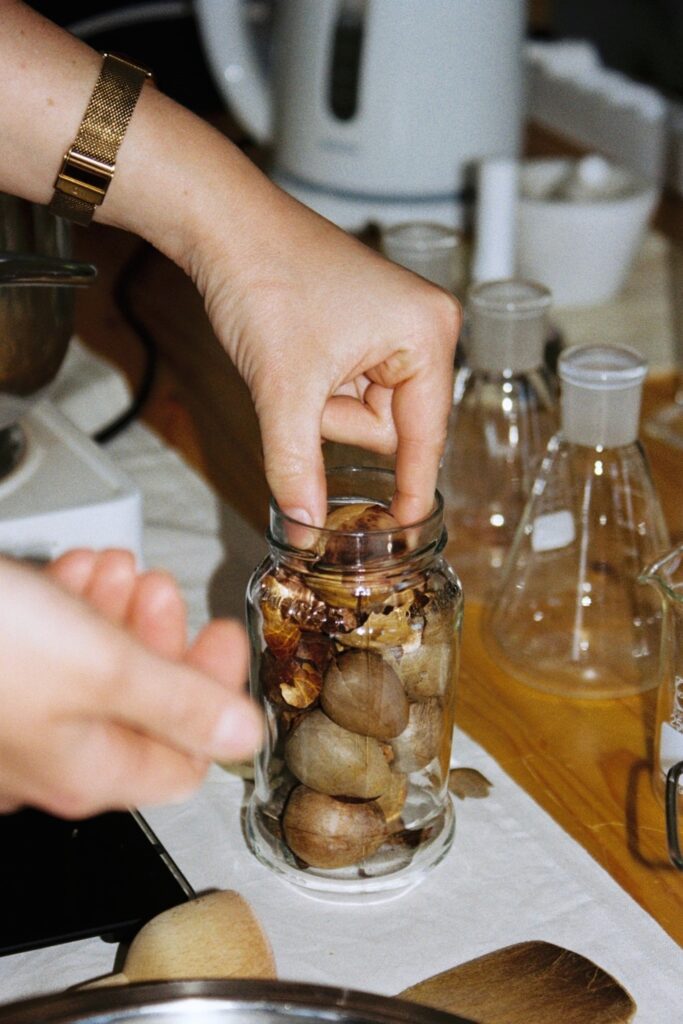Greta Desirée Facchinato is an Italian-Luxembourg artist and designer based in The Hague, Netherlands. Working symbiotically with nature, this biomaterials researcher also creates organic inks for screen-printing on textiles, including natural indigo, borage seed ink and avocado ink. Here she explains her approach and her motivation for becoming one with nature.
Where do you come from ?
I grew up in a beautiful area in Italy surrounded by hills. My family and my surrounding have taught me to care for nature since I was small. I remember going for long walks with my grandparents and my parents. My grandfathers taught us the wonders of nature by picking berries and making jam or eating tomatoes fresh from the garden still covered in soil. My mother would collect treasures like a rock or a pine cone along the way and gift them to me or my brother. My father, an agronomist and garden designer, would share with us the names of plants we would meet along the way. Both my grandmothers were tailors and I have seen them weaving stories on bodies since a very young age.
My background is rooted in multidisciplinary through the crossflow of different mediums and the investigation of daily life encounters, gestures, and materials. When I was little I started to dedicate myself to dance, a form of expression that invited me to a condition of self-reflection through the body and our sensorial experience. When I was nineteen I choose to do my Bachelors at the Academy of Fine Arts in Venice, specializing in the field of Sculpture. Here I met special mentors that supported me in the exploration of different techniques.
During those years I also learned the value of collaboration, for example by meeting fashion designer Silvia Sandri, with whom I keep on working today. Afterward, I moved to The Netherlands and pursued my Master in Artistic Research a Koninklijke Academie van Beeldende Kunsten (KABK) Den Haag. I graduated in 2018 with a project called FOAM : The Listening Body, researching the sense of listening, combining a publication with a textile/sensorial installation that invited me and the viewer to experience matter from an embodied awareness.
Why did you choose to investigate on new materials and how did you create your studio ?
I started Studio Greta Facchinato in Den Haag after graduating with my master’s in order to continue exploring my practice and in the last couple of years, I have been focusing on creative projects in the field of design for analog and digital media.
My investigation of biomaterials started around 2019/2020 with Soft Shucks and Fleshquake – in collaboration with Raquel Sánchez Gálvez. The projects arose from an interest in recreating aesthetic implants with biodegradable material obtained from agar-agar (seaweed). In 2021 I researched organic ink-making and screenprinting with the support of Gradische Werkplaats Den Haag and Gemeente Den Haag. Since then I am working with the knowledge of color and interconnectedness with our environment through the practice of sustainable ink-making for printing techniques.
The decision to investigate new materials comes from my interest in introducing in my practice an ecological and regenerative approach where human and non-human collaborates, where plants and micro-organisms are animate and included in the conversation in order to share a new design narrative.



What colors mean to you ?
Colors to me mean a connection to an ecosystem, to an environment that is within us and goes beyond. They mean relationships, memories, culture, ecological education and so much more.
Since my project Color is Alive (2021) with organic ink making for screenprinting, my idea of color completely shifted, from something abstract and inanimate to living matter. A color from a plant, the soil, or a microorganism invites us to understand our landscape and who inhabits it, beyond humans.
What have you recently discovered that can be applied on textiles and fashion ?
In the last two years, I applied the knowledge of bio-based ink-making (extracted from plants and microorganisms) to screen printing on textiles. This process allows us to print specific shapes and designs in a sustainable approach, by avoiding harsh chemicals and synthetic colorants which end up being discarded in our water and soil.
The inks can be applied for a small print such as a logo design or to create a pattern on a textile. This method of printing includes a holistic relationship with the plants and microorganisms involved, where the producer and the consumer become more aware.
How would you define your professional approach linked to nature ?
My approach is that of reciprocity where human and more than human life is not thought of as separate, but rather co-exist and find ways to collaborate symbiotically.
What are your projects ?
Currently, with The Ink Project – Between Craft and Technology, supported by The Creative Industries Fund NL, I am researching the potential crossover between the tradition of making ink with organic materials and its application to ink-jet printing. Interesting results could lead to ecological solutions in the field of digital printing for paper, textiles, and fashion.
I am looking forward to sharing this knowledge and results in a future exhibition and to engaging with further applications of bio-based ink by working with clients who share the same attention to circularity in the field of design and printing.
Photo One: Greta Facchinato by Raquel Sánchez Gálvez.








